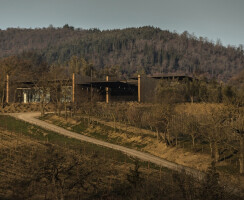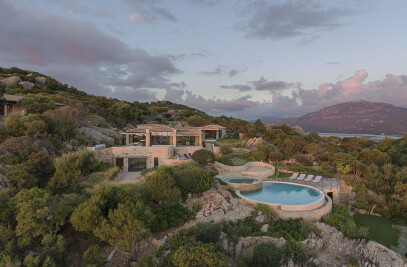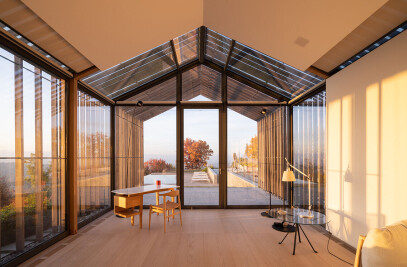The Winery at Podernuovo is located near San Casciano dei Bagni, in the outskirts of Siena, in Southern Tuscany. It overlooks a vineyard named after the agricultural estate it belongs to. The vineyard, designed to contain spaces accessible to the public, spaces of production, and offices endeavors to reduce as much as possible its impact on the environment.
The winery can be accessed from two points: the first situated by the service entrance near the loading docks, the second by the parking lot used by both visitors and staff. The main county road diverges, branching off into a local road (Strada delle Vigne, “of the vines” in English) which curves left, and intersects the access that leads all transport to the main terrace. By planning the entrance in this manner, the architects managed to avoid the overlap of flows between general and specialized traffic. This zone, on the Eastern side of the winery, is where the first parking area is found. The access road continues uphill towards a secondary parking area and ends at a third parking area, intended principally for staff and visitors. At this point the entrance used by the workers is also accessed, only separately, merging with the office spaces and the production areas, as well as passing by the changing rooms. This split access was intentionally designed in this manner to once more avoid interference with production.
Upon access through the principal loading dock, on the left are located three main program areas: the vat cellar, the barrel cellar, and the wine cellar where the bottled wine is stored and left to mature; on the right of the corridor, instead, the architects placed the zones where the final stages of wine production are undertaken (i.e. the main bottling area, a storage for oenological products, a secondary processing area where wine is fined in steel barrels), the staircase to the upper floors, the water reserves (intended for sprinklers, irrigation, flushing) and the warehouse space where the barrels are cleaned.
A height of +6.10 meters creates a series of interstitial zones amongst the intermediate programs, like the mechanical rooms above the main production space, the staff changing rooms, the toilets for visitors and the laboratories. The latter are accessed via a private staircase which also leads to the offices. At a similar height of +5.30 meters above the fermentation areas, a wine tasting room overlooks the program. Large panels of glass compose two sides of the room, allowing incredible visibility into the barrel storage area and into the garden, which is enclosed by two of the concrete walls and slopes towards the upper levels of the project. A ramp also at this level allows access to the exterior of the winery and continues the plane out towards the landscape. A large entrance serves as a vestibule for both the people who access the space via the staircase and those coming from the outside. By means of a glass door, the main corridor overlooking the terrace is once more accessed. The wine tasting room, the meeting rooms, the offices with six workstations, and toilets, can be entered from both sides of the axis. The production zones and the meeting rooms are enclosed by large glass walls that overlook the terrace which was partly tiled, whilst the rest forms a distinctive green roof over the program areas.
The shades are a distinctive detail throughout the building. Conceived as a light metallic frame structure, they cover the entrance, act as a roof in specific locations and protect the offices from direct sunlight. On the ground floor the large glass panels span the entire width of the rooms and visually connect the vat cellar with the exterior whichm during harvest, is transformed into an incredibly dynamic space and is one of the most fascinating sights to oversee.
The materials for the building were chosen to integrate the architecture, as much as possible, with the landscape of its surroundings. Exposed concrete, brick, klinker, varnished steel, glass are all the materials that characterize the envelope of the winery. The long walls that traverse and anchor the project are exposed and painted in a color similar to the hue of clay which characterizes the earth in Tuscany; it is as if they had just emerged from the ground to house a process older even than the Etruscan antecedents of the land. The building is further embellished by a green roof and shades over the offices and main production areas.
PROJECT DATA AND CREDITS architectural design: Alvisi Kirimoto + Partners client: Podernuovo a Palazzone of Giovanni and Paolo Bulgari structural engineering: ESAPROGETTI – Eng. Cianfrini / TECNO STUDIO – Eng. Lattini mechanical and electrical engineering: Studio Tecnico Emanuele Mucci and Fabrizio Corridori other consultants: Ing. Pupo (process systems) / TOSCANA PROJECT Srl (project management) contractor: ALTO soc. coop photos: Fernando Guerra | FG+SG fotografia de arquitectura (http://ultimasreportagens.com)

































